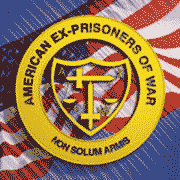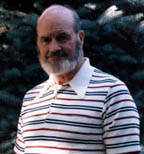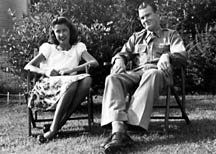
Established April 14, 1942
 |
American Ex-Prisoners of War
A not-for-profit, Congressionally-chartered veterans’ service organization advocating for former prisoners of war and their families.
Established April 14, 1942 |

Charles Brennan, 1985 |

|
|
| Last Name | First Name, Middle Init. | Nickname |
| Spouse | City | State, Zip |
| Conflict — Theatre | Branch of Service | Unit: |
| Military Job | Date Captured | Where Captured |
| Age at Capture | Time Interned | Camps |
| Date Liberated | Medals Received | |
| After the War ... | ||
After training as a pilot, I entered the Navigation School at Hondo, Texas where I graduated as a 2nd Lt. on October 7, 1943.
I was assigned to a B-17 crew at Pyote, Texas. The pilot was Ed Herman, co-pilot John Leathers, bombardier Victor Marck, engineer George Bingert, tail gunner Frank Komor, ball turret Bob Bunn, radio Matt Haebig, waist gunner Art Blanchard and Gene Earnest.
After training at Alexandria, Louisiana we went to Kearney, Nebraska where we picked up a new B-17 to fly to Europe. We first flew to Goose Bay, Labrador, then left for Europe on January 17, 1944.
After a 10-hour flight across the Atlantic we landed at Belfast, Northern Ireland. From there to England where we were assigned to the 334th Squadron of the 95th Bomb Group at Horham, England on February 28, 1944.
Our first mission on March 3rd was Target Berlin, however this mission was aborted by the entire 8th Air Force due to bad weather. On March 4th, the 95th Bomb Group, together with one squadron from the 100th Group, made the first B-17 attack on Berlin. The rest of the 8th Air Force bombed targets of opportunity or returned directly to England. The 95th B.G. had "ignored" orders to abort the mission, and we received a Presidential Unit Citation for this action. We lost 4 aircraft.
On March 67th we went to Berlin again. Flak and enemy fighters shot down sixty-nine bombers and eleven fighter planes of ours. This was the greatest loss of aircraft suffered by any mission during W.W. II. Our plane "Patches" was so badly damaged that it had to be scrapped.
Our 6th Mission was to Augsburg, Germany where our plan was so damaged by flak and enemy aircraft that we headed for Switzerland for safe haven. We didn't make it and were forced to parachute from 22,000 feet. I landed in the mountains of the Bavarian Alps where I was injured on landing and captured by German civilian patrols. The German leader of the group placed his pistol to my head. Before he could pull the trigger, a German soldier rescued me.
After spending three days in solitary confinement at the Interrogation Center at the Dulag Luft Camp near Frankfurt, I was transferred to a small transit camp located in the center of the city of Frankfurt. The RAF bombed this camp in error completely destroying it. Several POWs were killed. I lost part of my hearing from this raid. The Germans then marched us 12 miles through Frankfurt where we were under constant attack from the civilian population.
We reached our POW Camp, Stalag-Luft III, near Sagan, Germany. The day of the "Great Escape" -- March 26, 1944. In this escape 80 R.A.F. POWs had tunneled out. Upon capture the Gestapo executed 50 of these R.A.F. POWs.
After 10 months at Sagan, the Germans evacuated us when the invading Russian Army was only 30 miles from our camp. Ten thousand POWs started on the Death March January 27, 1945. We walked through the blizzard, temperatures far below zero in Germany's coldest winter in 100 years. We walked 83 kilometers in 3 days. We slept on the ground or in barns. Very little food, inadequate clothing, constant snow and freezing. Many died.
We reached the town of Sprenberg where we were loaded on cattle boxcars, locked in with no food or water for 3 more days.
About February 3rd or 4th we arrived at Mooseberg, Germany, north of Munich. This was the 'Hell' Camp. One POW said at the time, "I must be dead and this is Hell."
The 14th Armored Division of the 3rd Army liberated us here on April 29, 1945. General Patton entered the camp.
Taken at first by C-47's to Le Harve, France, we returned by ship to America in June 1945.